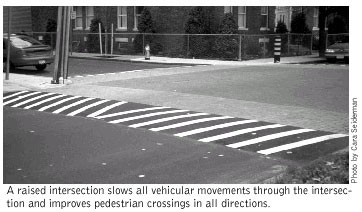29. Raised Intersection; 30. Raised Pedestrian Crossing
 A
raised intersection is essentially a speed table (see photo below) for
an entire intersection. Construction
involves providing ramps on each intersection approach
and elevating the entire intersection to the level of the sidewalk. They
can be built with a variety of materials, including asphalt, concrete,
or pavers. The crosswalks on each approach are also elevated as a part
of the treatment, to enable pedestrians to cross the road at the same
level as the sidewalk. This is good for mobility impaired pedestrians
but may cause problems for the sight impaired if they cannot detect the
curb edge.
A
raised intersection is essentially a speed table (see photo below) for
an entire intersection. Construction
involves providing ramps on each intersection approach
and elevating the entire intersection to the level of the sidewalk. They
can be built with a variety of materials, including asphalt, concrete,
or pavers. The crosswalks on each approach are also elevated as a part
of the treatment, to enable pedestrians to cross the road at the same
level as the sidewalk. This is good for mobility impaired pedestrians
but may cause problems for the sight impaired if they cannot detect the
curb edge.
A raised pedestrian crossing is also essentially a speed table, with a flat portion the width of a crosswalk, usually 10-15 feet. Raised intersections and crosswalks encourage motorists to yield. On one street in Cambridge, Massachusetts, motorists yielding to pedestrians crossing at the raised devices went from approximately 10% before installation of the project to 55% after installation.


Purpose:
- Tend to be the most predictable in reducing vehicle speeds.
- Enhances the pedestrian environment and pedestrian crossings.
Considerations:
- Don't use if sight distance is limited and/or the street is steep.
- If the street is a bus or emergency route, design must be coordinated. One device may be appropriate and may serve the primary need. Several raised devices may be disruptive, so other measures should be considered.
- Speed tables and raised cross-walks and intersections can be an urban design element through the use of special paving materials.
- Add tactile warning strips at edges to enable site impaired people to detect the crossing.
- Care must be taken in adding drainage.
Estimated cost
Raised crosswalks are approximately $5,000 - $7,000, depending on drainage conditions and materials used. The cost of a raised intersection is highly dependent on the size of the roads They can cost from $25,000 to $70,000.